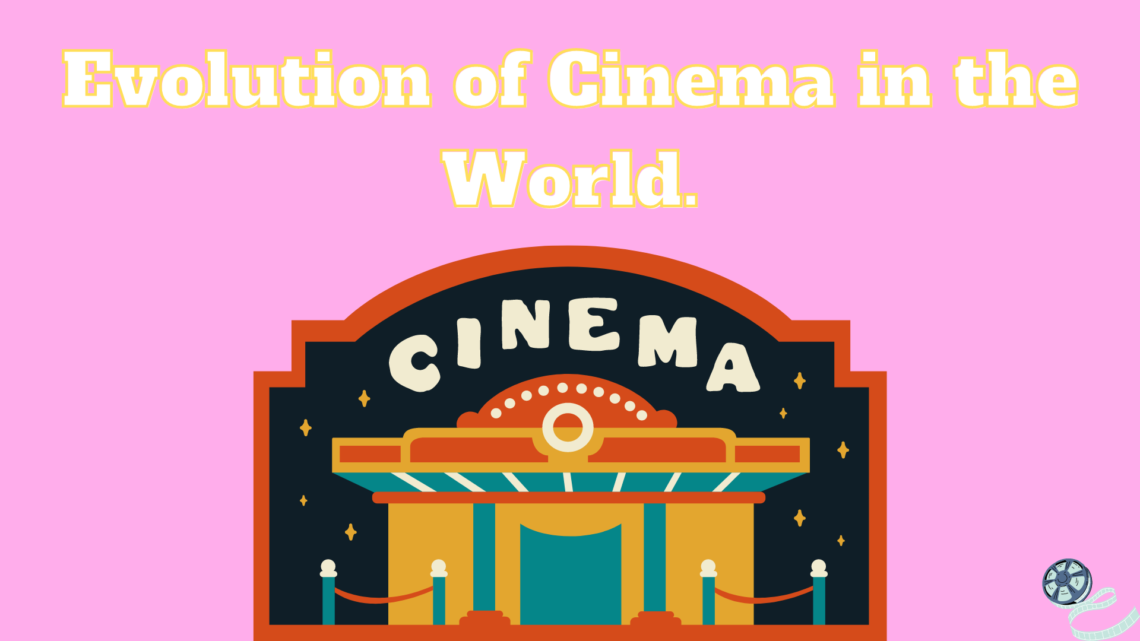
Evolution of Cinema in the World
Cinema is a motion picture that keeps you entertained for some time and helps you escape reality. Cinema became a household name as time went by. It helped some understand and express their emotions freely, whereas it helped others understand how others feel in this world. Cinema is a common medium for us all, bringing issues to light in front of the whole world and giving us meaning and perspective. So, how did cinema happen?
Kinetoscope
Kinetoscope originates from a Greek word that means movement-watcher. It was the first device developed to show moving pictures. Kennedy Laurie Dickson, a British employee of Thomas Alva Edison, invented the Kinetoscope at the end of the 1880s. Soon, they opened parlors in New York and London, showing 20sec films on a continuous loop. The device allowed only one user to watch through a peep-hole. It inspired many other similar instruments later like Lumiere Cinematographe, The Theatre Optique, Electrotachyscope, and at last came the movie projector. Earlier sound couldn’t be recorded, so to include sound, dialogue, and music, live performances along with showing pictures using these instruments was done.
The Silent Era
La Sortie des ouvriers de I’usine Lumiere, the first motion picture was showcased in 1895 in Paris. Initially, the movie’s length was concise, ranging from 15 to 20 minutes. George Melies released A Trip to the Moon in 1902, adding double exposure and special effects, increasing the standard for production value. Films did not have sound and were known as silent films. From the mid-1890s to the late 1920s, the era was known as the Silent Era. Titles or inter-titles were introduced into motion pictures.
The Fairy of the Cabbages, released in 1896, was the first movie by a female director. The May Irwin Kiss, an 18-sec film released in 1896, led to film censorship. Four Horsemen of the Apocalypse, The Oxford and Cambridge University Boat Race, The Execution of Mary Stuart, and The Indian Chief and the Seidlitz Powder are a few silent films from the beginning of the era.
In 1905, Nickelodeon opened in Pittsburgh, the first thriving permanent theatre showing only films. Film techniques like fire effects, Low-key lighting, Point of View, and insert shots developed in the silent era. The Fatal Hour, Back to Nature, The Birth of a Nation, Intolerance, The Avenging Conscience, Woman in the Moon, Devdas, and Lanka Dahan are a few notable films of the silent era. In 1920, the US produced 800 feature films annually, i.e., 82% of the global films.
The Sound Era
Warner Bros released The Jazz Singer in 1927, a mostly silent film with synchronized dialogue, marking a new era of sound in cinema. Many films before this contained only records of talks and music. The Jazz singer influenced many films with sound and synchronized dialogue. By the end of 1929, most of Hollywood was filled with sound films, which were then called “talking pictures”.
A standardized sound system was soon established and adopted in different parts of the world like Russia, Germany, India, China, and Japan. The Broadway Melody, 1929, was the first musical film. Many directors experimented with sound and pushed technical advances in microphones and cameras. Horror films like Dracula and Frankenstein were also released.
Europe and India made their mark in film-making in the sound era. India, a diverse country with vibrant folk music, began hugely famous and quickly successful with musicals in films. Sound in cinema reached India lately, in the 1930s. Alam Ara, Kalidas, Pukar, Apradhi, Roop Lekha, Devas, and Amrit Mantha are notable films in the sound era in India.
Colour in Cinema
Only green and red colors were seen on the screen in the beginning. In London, color in movies is said to be first observed in 1909 in an untitled film created by Edward Raymond Turner and Frederick Marshall Lee using the Kinemacolor technique. In 1916, the technicolor technique used three colors, green, red, and blue. Walt Disney’s Flowers and Trees in 1932 was the first audio-visual piece to be released. The Vanities Fair in 1935 was the first technicolor film. Later, many movies began implementing different color techniques, and color movies emerged in all parts of the world.
The Golden Era
The golden age for Hollywood is said to begin in the late 1940s during World War 2. Classic films like A Canterbury Tale, Pinocchio, Bambi, Casablanca, The Best Years of Our Lives, Rome, The Vikings, Around the World in 80 Days, Oklahoma! Cleopatra, Cinderella, Peter Pan, and Old Yeller were released in Hollywood in this era. The era is said to be ended by the end of the 1950s.
The golden age of Asian cinema started in the 1940s as well. The 1950s decade marked a golden age for non-English cinema worldwide. Notable Asian films like Tokyo Story, The Apu Trilogy, Sansho the Bailiff, Yangsan Province, Floating Clouds, Seven Samurai, Awaara, and Pyaasa were released in the golden era. The end of the Golden era marks the end of the vintage cinema era. Movies that came before the 1960s from the 1920s are considered to be vintage cinema.
The Blockbuster Era
The 1960s and 1970s are considered the blockbuster era in world cinema. Before, films were made in studios using special effects and film techniques. In this era, moviemakers started going to different locations to film—many movies from the vintage cinema era restructured storytelling and narratives and influenced upcoming movies globally.
Mary Poppins, Breathless, Jules et Jim, La Dolce Vita, Blow up, My fair lady, The Sound of Music, Dr. No, Dearer than my life, Saladin, Dr. Strangelove, Bonnie and Clyde, A Space Odyssey, Yojimbo, and Mughal-E-Azam are hit in the 1960s.
A Rebel Without a Cause, Annie Hall, Manhattan, Chinatown, Enter the Dragon, Drunken Master, Sholay, and Mad Max are global critically acclaimed movies in the 1970s.
Television and Cinema
After hitting the theatres, Television is the next screen a film is presented. Television also became a considerable influence as well as competition for the theatres. Theatres saw a relatable downfall initially after Television was introduced. But with the innovation of 2D and 3D films, Television rebounded quickly. Television promoted films more and encouraged the audience to experience the theatrical experience. Cheap budget movies and made for tv films and shows began to hit Television directly instead of theatrical releases. Some Television shows also influenced movies.
Independent Era
The early 1980s saw a massive number of independent films by independent filmmakers produced on a low budget. They saw commercial success at theatres as well as home screens. The 1980s and 1990s periods are known as the independent era. In this era, movies like Sex, Lies and Videotape, Reservoir Dogs, and Edge of Seventeen were released. The rise of independent artists and production houses in the film industry happened in the mid-1980s.
The 1990s was also when many companies like DreamWorks, Pixar, warner bros, Disney, and 20th-century fox produced animated movies. Movies like beauty and the beast, Aladdin, the lion king, and toy story did well globally.
The Birth of a Nation, City Lights, King Kong, Snow White, and the Seven Dwarfs, The African Queen, To Kill a Mockingbird, Star Wars, Schindler’s List, The Matrix, and The Shawshank Redemption are notable hits of the 20th century globally.
21st Century Cinema
Streaming platforms like YouTube started gaining popularity in the 20th century. Many short films and web series started to release directly on online platforms. The film industry shifted focus to animation, 3D and epic-like fantasy, and superhero genres to make them successful at theatres. Audio and visual experience increased in the theatres mainly in the 20th century due to the evolution of technology.
Documentary films like March of the Penguins, Voice of Iraq, Earth, Salam Neighbour, Living on One Dollar, and Bombay Beach gained popularity quickly. Epics like the Harry Potter series and The Lord of the Rings trilogy were massive hits on theatres and home screens. DVD editions of films became widely popular. 3D movies like Ghosts of the Abyss, Spy Kids 3D: Game Over, The Adventures of Shark boy and Lava Girl in 3-D, Avatar, and How To Train Your Dragon became among the highest-grossing films.
Films based on comics by DC and Marvel became popular in the 2010s. Avengers: Endgame, released in 2019 by Marvel, is one of the box office’s most successful movies. Not only this, many novels turned into movies and tv shows. More streaming platforms like Netflix, HBO Max, Disney, and Amazon Prime gave global film access and increased global audience.
Some of the 21st century critically acclaimed highest-grossing films globally are Finding Nemo, The Wolf of Wall Street, Before Sunset, Spring, Summer, Fall, Winter and Spring, Ida, The Assassin, 12 Years a Slave, The Social Network, Baahubali, KGF 2, Dangal, Star Wars: The Force Awakens, Parasite, Train to Busan, Ode to My Father, The Battle at Lake Changjin, Operation Red Sea, Welcome to the Sticks, Raging Fire, and A Little Red Flower.




